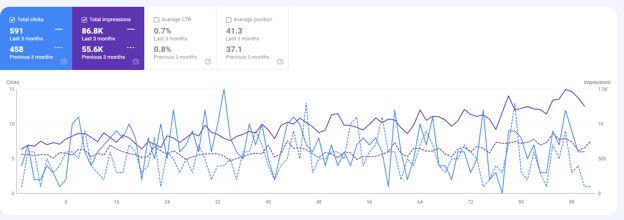Understanding User Behavior Metrics for SEO Success
User behavior is a critical aspect of SEO that involves tracking and analyzing visitors' actions on a website before and during their visit. This...
%20(1)-3.png)
Search engine optimization (SEO) is a long-term marketing strategy. Rather than paying for advertisements on Google or social media platforms to quickly drive traffic to your site, investing in SEO involves making changes that can take time to have an observable impact. That being said, it’s important to collect as much data as possible as you begin your long-term SEO strategy to identify trends as they emerge.
Let’s take a look at how to spot trends in SEO data.
Before you begin your long-term SEO strategy, you should have a goal in mind. Typically, businesses want to drive more traffic to their website. However, it’s important to create objective, measurable goals that can be tracked over time. For example, a company might start with this core SEO goal:
Increase organic search traffic by 10% within one year.
Based on that goal, the marketing team will want to look at week-over-week, month-over-month, and year-over-year comparisons to track progress.
After establishing the SEO goal and implementing the new strategy, marketing analysts must turn to multiple data sources to get a full picture of what is going right or wrong. Looking at Google Analytics data and Google Search Console data is a good place to start.
For our example goal, we will need to identify KPIs to track over time. I’d recommend starting with GSC clicks and impressions, and GA sessions and users.
Google Search Console provides an easy-to-use interface for graphing out clicks and impressions over time. In addition, you’ll want to use a comparison period as a baseline. For example, when beginning your SEO project, you might want to look at how organic traffic increased over the past 3 or 6 months to get a baseline percent change.

Based on this example chart, we can see that prior to the SEO intervention, this company saw a 29% increase in clicks looking at 3 months of data compared to the prior 3 months. In addition, the CTR actually decreased slightly and the average position dropped, so this is a good indication that there’s a high opportunity for growth.

Now that you know where your business stands in terms of SEO, it’s time to work on updating the website and adding content to boost performance. After implementing these changes, it’s crucial that analysts track week-over-week performance, but do not change anything until testing the campaign for 30 days.
Below is an example of a week-over-week graph of GSC data.

At a quick glance, the performance looks like it declined. Clicks, CTR, and average position dropped week-over-week. However, as we stated earlier, SEO is a long-term strategy. Two weeks of data are not enough to warrant a change in a new strategy. Therefore, we’ll wait another week and look at the new trend.

Now based on this week-over-week comparison, it looks like things improved again. Clicks, impressions, and CTR all increased. On the other hand, the average position continued to drop. That being said, while we don’t notice a consistent trend yet in terms of clicks, impressions, and CTR, we do want to note that the average position has dropped two weeks in a row.
Let’s say that we continued to track the average position for another week. At what point does this become a trend? For this, it’s helpful to look at a month-over-month comparison in conjunction with the two week-over-week graphs.

Based on the graph above, we see that the average position has indeed been dropping. Now, we feel confident that this is a downward trend and it’s time to intervene.
Now that you found a downward trend, it’s time to dig deeper into the data. This is when intensive marketing analytics come into play. By isolating which pages are dropping in rank and which keywords are driving this drop, it’s easier to address the problems. Whether it’s developing new content, reheating old blog posts, or changing the metadata, everything should be driven by the data.
It’s easy to assume that SEO is a black-box strategy, but in fact, we can isolate the factors that contribute to a site’s performance. Contact Hire a Writer today to learn how our SEO analysts can help you develop your data-driven strategy for organic growth.

User behavior is a critical aspect of SEO that involves tracking and analyzing visitors' actions on a website before and during their visit. This...

Unlock the benefits of structured data with our comprehensive guide to starting with FAQ schema. Elevate your website's visibility on Google and...
.png)
2 min read
Structured data refers to a method of organizing and presenting information on a web page in a format that search engines can easily...